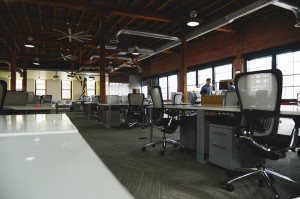Paula Marshall, head of furniture and category sales at Office Depot UK and Ireland, shares her tips on how employers can adapt to a smaller workplace
Often, the luxury of space can come at a high expense, especially for businesses looking to locate themselves in city centres. To combat this increased cost, many SME business owners are considering downsizing, opting to rethink their office layouts rather than stump up for larger premises.
In addition to the positive effect a smaller office can have on a company’s monthly outgoings, choosing to downsize can enhance how employees accomplish their daily tasks if they are working in a brighter, creative and more collaborative space. In order for downsizing to be effective, organisations should bear in mind evolving ways of working, such as remote or flexible working, during the initial office design phase.
Successfully maximising usage of a smaller space requires facilities managers (FMs) to understand the workflow of the business. This involves an awareness that styles of working are constantly changing and, in particular, that more and more employees are choosing to work remotely. For example, workflow analysis often reveals how working in a small environment can be disruptive unless properly managed, for office-based staff, with employees frequently coming and going.
Before businesses begin downsizing, they need to think about their key requirements and consider the area in its entirety. Having a planned design in mind at the start of the process is essential if the office space is going to be uniform and well-designed.
Accordingly, businesses should avoid designing an office around existing furniture and should be open to moving away from the traditional work space. Especially when trying to maximise smaller spaces, FMs need to understand the nature of the office space and what architectural design is needed to maximise it effectively. Only then can a decision be made on what furniture fits into the space and whether it fully meets the needs of users. Once a business has thoroughly thought about how to make a downsize work, it is important to consider what furniture and lighting can be used to carry out this plan.
Before businesses begin downsizing, they need to think about their key requirements and consider the area in its entirety
Adapting current setups is an important first step and may involve upcycling existing furniture into pieces that can be used for more than one function. For instance, low storage units can be turned into extra seating, walls can be used for white boards and the sides of metal cupboards can have magnetic pin boards, reducing the need for extra unnecessary wall space.
Clever zoning, making use of different materials or colours, is a simple method which can give the workspace character and a sense of order, allowing employees to distinguish where to go for informal chats or formal meetings. Hanging acoustic panels can also be used to trap noise, making areas more private without being completely excluded by blockades or barriers.
Furniture and lighting are two fundamental elements which should not be forgotten when businesses are planning an office downsize. When deciding to purchase new furniture, businesses should keep in mind its practicality: can it be folded, stacked, or wheeled away when not in use? Likewise, sofas and armchairs that are on raised legs and are a light-coloured fabric can create a sense of light and space in the room, in comparison to heavier and darker alternatives.
Lighting is arguably the easiest and most cost-effective method for companies looking to maximise space in a smaller office. Some workspaces have no windows, creating a claustrophobic working atmosphere and imitation skylights can instead be utilised to raise lighting levels and make workers feel comfortable. Light tubes which change throughout the day from white and blue hues in the morning to white and red hues in the afternoon can also add variety to the office environment and help keep body clocks in sync, replicating the natural change in daylight.
As long as FMs regard downsizing as an entire project instead of thinking about architecture, design or furniture in isolation, the decision to downsize can be a clever way for businesses to make the most of their office space whilst also saving money. Taking all of these elements into account will ultimately result in a consistent office-wide design which will give the workspace a sense of unity and structure.















